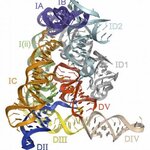Microbiology

Bubonic plague has killed hundreds of millions of people during the course of history. It is the most devastating acute infectious disease known to man. Scientists remain uncertain about the molecular basis of its extraordinary virulence.
Bacteria that cause the bubonic plague may be more virulent than their close relatives because of a single genetic mutation, according to research published in the May issue of the journal Microbiology.
“The plague bacterium Yersinia pestis needs calcium in order to grow at body temperature. When there is no calcium available, it produces a large amount of…

Fungi produce a number of natural products. Some are potent toxins, like the amanitins primarily responsible for the toxicity of the death cap fungus. Others are life-saving drugs such as penicillin. Because of that diversity, the genetics of fungi have generated much interest in recent years.
Many fungi have a wealth of genes encoding for far more natural products than they actually produce, says Robert Cichewicz and colleagues at the University of Oklahoma, Norman. The explanation is thought to be that when fungi do not need certain compounds, they inhibit the transcription of the DNA…

Scientists at The Australian National University are a step closer to understanding the rare Hartnup disorder after discovering a surprising link between blood pressure regulation and nutrition that could also help to shed light on intestinal and kidney function.
The team from the University’s School of Biochemistry and Molecular Biology together with colleagues from the University of Sydney set out to study nutrient uptake in the intestine and discovered an essential role of a protein called ACE2 in the process. ACE proteins cut off a small part of a precursor molecule generating a hormone,…

New heart research published inNature Genetics reveals how a gene called osteoglycin (Ogn), which had not previously been linked with heart function, plays a key role in regulating heart growth. The study suggests that the gene can behave abnormally in some people, and that this can lead to the heart becoming abnormally enlarged.
The researchers hope that through understanding how enlarged hearts are linked to the workings of genes like Ogn, they will be able to develop new treatments for the condition, which affects a large proportion of those with high blood pressure, obesity and diabetes.…

Dutch researchers at University Medical Center Utrecht and the Hubrecht Institute have succeeded in growing large numbers of stem cells from adult human hearts into new heart muscle cells.
Prior to this, it was necessary to use embryonic stem cells. Their findings are published in the latest issue of the journal Stem Cell Research.
The stem cells are derived from material left over from open-heart operations. Researchers at UMC Utrecht used a simple method to isolate the stem cells from this material and reproduce them in the laboratory, which they then allowed to develop. The cells grew…

Researchers seeking new and more abundant sources of stem cells for use in regenerative medicine have identified a potentially unlimited, noncontroversial, easily collectable, and inexpensive source – menstrual blood.
Stromal stem cells - cells that are present in connective tissues - have recently been identified in endometrial tissues of the uterus. When the fresh growth of tissue and blood vessels is shed during each menstrual cycle, some cells with regenerative capabilities are present and collectable. While collecting menstrual blood stromal cells (MenSCs) directly from tissue would be…

Eczema is a distressing condition for both parents and babies – the raw, red skin is painful to see and it is difficult to stop small children from scratching it. At worst, it can mean having to wet wrap wriggly toddlers each day with bandages soaked in moisturisers. It usually starts in the first year of life and affects about 10% of infants. Although most children eventually grow out of it, about half will go on to develop another allergic condition, such as asthma or hayfever.
Recent progress in understanding the role of gut bacteria in the development of the infant’s immune system has led…

The nature vs. nurture debate is familiar to most people, and modern conclusions usually predict a balance between the two. A new paper shows that there is a similar balance between inherited genes - nature - and the environment - nurture - in determining thousands of traits in yeast.
As we approach the age of personal genomics, in which each of us knows something about the genetic variations we carry, it is important to understand how genes and the environment interact in order to draw medically sound conclusions from the information available, e.g. whether exercise can reduce risks that…

Biochemists at the national meeting of the American Chemical Society have described how proteins in alligator blood may provide a source of powerful new antibiotics to help fight infections associated with diabetic ulcers, severe burns, and “superbugs” that are resistant to conventional medication.
Previous studies by Merchant showed that alligators have an unusually strong immune system that is very different from that of humans. Unlike people, alligators can fight microorganisms such as fungi, viruses, and bacteria without having prior exposure to them. Scientists believe that this is an…

Recent research at Yale provided a glimpse of the ancient mechanism that helped diversify our genomes; it illuminated a relationship between gene processing in humans and the most primitive organisms by creating the first crystal structure of a crucial self-splicing region of RNA.
Genes of higher organisms code for production of proteins through intermediary RNA molecules. But, after transcription from the DNA, these RNAs must be cut into pieces and patched together before they are ready for translation into protein. Stretches of the RNA sequence that code for protein are kept, and the…